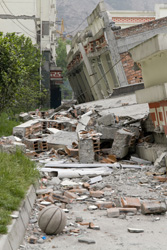Predicting site-based earthquake effects
Earthquakes can be very destructive. However, sometimes the surface geological conditions that may amplify seismic effects cause more destruction than the earthquake itself. For example, after an earthquake, soft sedimentary basins can shake with much greater force and longer duration, than more solid ground. In such cases, even a mild earthquake can be extremely destructive. Taking better account of these 'site effects' is vital for accurate assessment of earthquake risks and mitigating their hazards. The EU-funded SEAR project has developed simpler and more reliable methods for assessing site effects to improve site characterisation. The study optimised mathematical tools for better site assessment and seismic wave-movement prediction using waves' frequencies and other factors. The project's second goal was to improve site effect assessment. SEAR came up with two approaches, also using complex mathematical techniques relying on the properties of seismic waves and curves. The first solution uses Japanese data to assess earthquake-site effects from easily available information. The resulting equation allows a robust calculation of site effect from two simple wave parameters — Vs30 (time-average shear wave velocity of the first 30 metres) and fundamental resonance frequency (f0). These parameters are considerably more accurate than current European calculations. The second solution concept is more original, and was proposed at a national conference. It relies on dispersion curve data, meaning that only a few high-frequency samples would be necessary to obtain site effect assessment equivalent to classical methods. However, this solution still needs further testing. SEAR research outcomes should lead to better estimates of the local effects of a given earthquake, resulting in appropriate building codes’ keeping safety in mind.



